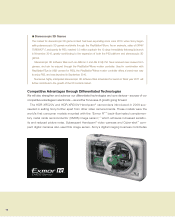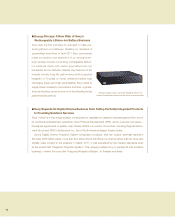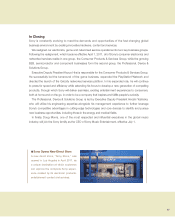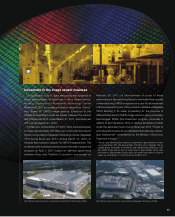Sony 2011 Annual Report Download - page 24
Download and view the complete annual report
Please find page 24 of the 2011 Sony annual report below. You can navigate through the pages in the report by either clicking on the pages listed below, or by using the keyword search tool below to find specific information within the annual report.
22
With the “Exmor R” back-illuminated CMOS image sensor,
light is directed onto the silicon substrate from behind, allowing
light to be used with a level of efficiency not possible with
conventional front-illuminated pixel structures. Photographers
can now create smooth, high-quality images in low-light
settings. For example, the Cyber-shot digital cameras
incorporating the “Exmor R” also utilize Sony’s BIONZ image
processing engine. By combining these two technologies, the
camera fully comes into its own in such low-light scenarios as
By directing light onto the silicon substrate from behind, the increased efficiency in
light use makes high-quality images possible even in low-light settings
night panoramas and indoor shots—which were previously
difficult to shoot well on a compact digital camera. This
architecture means photographers need not use a flash but
can still achieve low noise, vibrant, clear images. By deploying
the “Exmor R,” it is possible to use multiple metal wiring layers
and arrange the transistors with greater freedom. These
advantages are expected to result in a variety of advances,
including further improvements in speed and dynamic range.
Image sensors are imaging elements that may be thought of as
the “eyes” of digital video and digital cameras. In 1978, Sony
announced that it had developed a 110,000-pixel charge-
coupled device (CCD) image sensors. Since then, Sony
has continued to develop its own image sensor technology,
and in recent years, in addition to the high-resolution pixel
technology it has cultivated in the CCD field, Sony has pursued
the development of high-resolution and high-speed CMOS
Sony aims to be the world’s leading company in both CCD and
CMOS image sensor technology
image sensor technology. This has included the “Exmor,”
which utilizes proprietary on-chip column A/D conversion
and dual noise reduction. Furthermore, by developing the
back-illuminated CMOS image sensor—an architecture long
considered technically difficult to achieve—Sony has realized
further enhancements in sensitivity as well as noise reduction.
Sony has for many years maintained the leading market
share for CCD image sensors. From fiscal year 2009 (the
16.41 effective megapixels back-illuminated
CMOS image sensor for mobile phones
16.41 effective megapixels lens module
for mobile phones
8.13 effective megapixels lens module
for mobile phones
* TECHNO SYSTEM RESEARCH, November 2011.
























